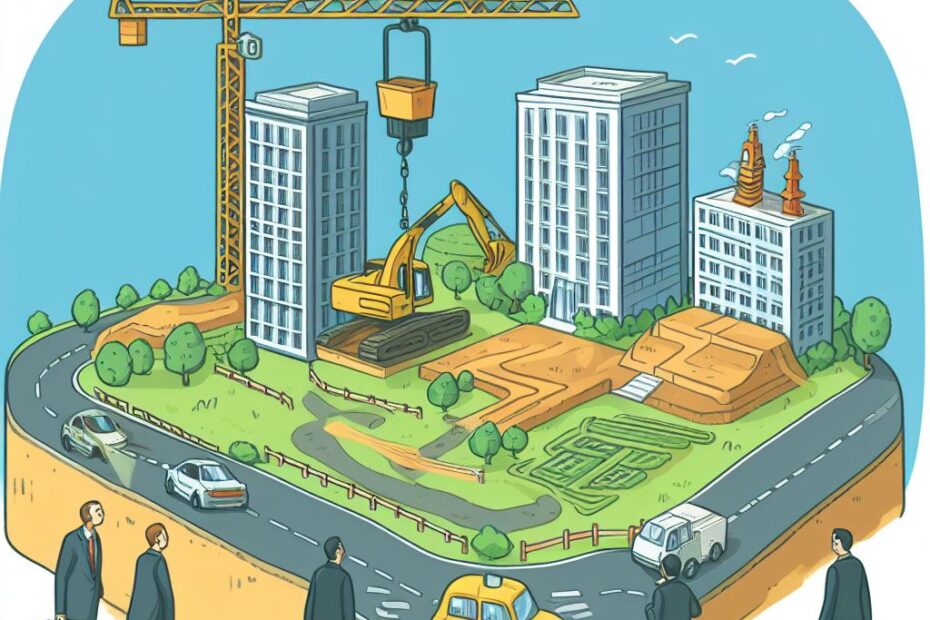Land development for commercial use is a multifaceted process that requires careful planning and execution. This article will guide you through the steps you need to take to develop land for commercial use effectively.
The process of land use planning is a pivotal first step in the development of land for commercial purposes. This process is a strategic approach to resource allocation and policy-making, aimed at optimizing land development for the collective benefit of an area’s inhabitants.
Land use planning is an essential tool for community leaders to manage and allocate resources effectively. It involves the creation of policies that guide the utilization of land, ensuring that the land development aligns with the general welfare of the area’s residents.
This process is not just about zoning and regulation, but also about understanding and addressing the unique characteristics and needs of the community. It involves leveraging the region’s unique parks and natural resources, promoting the expansion of bicycling and walking infrastructure, and developing a regional housing strategy.
Land use planning also plays a crucial role in promoting health equity. By influencing elements of the built environment, such as building placement, density, architectural and landscape design, parking, and street maintenance, land use planning can contribute to a healthier community.
Furthermore, land use planning is also about considering environmental sustainability. It involves methods for reducing waste, limiting pollution, and encouraging public transportation usage.
Land use planning is a comprehensive process that involves community leaders in creating policies that guide the utilization of land. It is a strategic approach that considers the unique characteristics and needs of the community, promotes health equity, and contributes to environmental sustainability. Understanding and implementing land use planning is a crucial step in the development of land for commercial use.

Identifying the Type of Commercial Development
Understanding the nature of the commercial development you aim to undertake is of paramount importance. It could involve the creation of a single-family or multifamily residence, a condominium complex, or a commercial property.
This process of identification is crucial as it lays the foundation for your future venture. It helps in defining the scope of your project, the resources required, and the potential return on investment.
The type of commercial development you choose to pursue can significantly impact your project’s success. Therefore, it’s essential to carefully consider your options and make an informed decision.
For instance, a single-family residence might be a good choice if you’re looking for a lower-risk, higher-profit venture. On the other hand, a condominium complex or a commercial property could be more suitable if you’re aiming for a higher return on investment, but are willing to take on more risk.
Identifying the type of commercial development you want to pursue is a key step in your project. It helps you define your goals, make strategic decisions, and ultimately achieve your financial objectives.

Zoning Regulations
Zoning regulations play a pivotal role in shaping your plans for land development. They dictate whether constructing a commercial property is allowed on a specific lot, thereby influencing the feasibility of your development projects. It is crucial to comprehend these regulations before initiating any development process.
Zoning regulations are laws that divide municipalities into different zones or districts, each with specific land use restrictions and requirements. These regulations are established to ensure that land use is organized in a way that promotes safety, efficiency, and the well-being of the community.
To navigate the zoning regulations, you should familiarize yourself with the local zoning codes and ordinances that apply to your project. These codes outline the permitted uses, building heights, setbacks, parking requirements, and other development standards for each zone.
Identify the zoning district(s) in which your property is located. Different districts have distinct allowable uses. Ensure that your proposed development aligns with the designated zoning district.
In some cases, you may need to apply for a zoning variance or a special permit if your project deviates from the existing zoning regulations. These require a detailed application process and approval from the local zoning board.
Zoning regulations are essential when buying and selling land and buildings. These regulations limit what you can do and how you can do it. For instance, in certain counties and cities, you may not be able to build certain structures or have houses close together.
The best approach to zoning regulations is to do your research! Know exactly what you’re getting into before proceeding. Seek advice from developers and those familiar with zoning regulations. Check the department website for the latest regulations. Be prepared for inspections and ensure your compliance to avoid delays.
In conclusion, navigating the legal considerations of zoning and land use is fundamental to successful commercial property development. Understanding zoning regulations, adhering to land use planning, securing necessary approvals, seeking legal counsel, and maintaining ongoing compliance are crucial steps to ensure that your project aligns with local laws and regulations, ultimately leading to a successful and legally sound commercial property development.

Financing Your Commercial Development
When planning a commercial development, the type of financing you seek will largely depend on the intended use of the property. One of the most critical factors to consider is the loan-to-cost ratio (LTC), a measure that indicates the proportion of the project’s total cost that lenders are willing to finance.
The LTC ratio is calculated by dividing the total loan amount by the total development cost of the project, expressed as a percentage. This ratio is a crucial tool used by underwriters in the commercial real estate market to determine the appropriate proportion of debt to offer to a borrower relative to the total capital required to fund a project.
For instance, if a project’s total cost is $650,000, and a lender is willing to provide a loan of $400,000, the LTC ratio would be calculated as follows:
LTC = (Loan Amount ÷ Total Project Cost) × 100 = ($400,000 ÷ $650,000) × 100 = 61.54%.
The LTC ratio is not the only factor lenders consider when assessing a loan application. Other factors may include the location of the project, the value of the property, the borrowers’ credit record, and loan histories.
Moreover, lenders also evaluate the reputation, credibility, and experience of the investor, builder, and project manager.
In addition to the LTC ratio, lenders also consider the Debt Service Coverage Ratio (DSCR), a measure of a borrower’s ability to pay their debts based on the business cash flow. It’s calculated by dividing your annual net operating income by your total annual debt payments.
The LTC ratio is a crucial factor in determining the amount of financing you can secure for your commercial development. However, it’s just one of many factors that lenders consider, so it’s important to also consider your credit history, the value of the property, and your ability to repay the loan.

Construction and Development
In the realm of real estate investment, one common practice is to engage in horizontal property development, which includes activities such as road grading, curb installation, and utility setup. This process is typically followed by constructing the building from the ground up. This approach is often taken because it allows investors to have a direct hand in the development process, from the initial planning stages to the final construction.
The process of construction financing is also a crucial part of real estate investment. It involves securing funds for the construction and development of the property. The capital stack, which refers to the layers of financing that make up a project, usually comprises both debt and equity, and highlights the priority at which interested financial parties hold claims for repayment.
The development process typically involves several stages. The first stage, pre-development, involves acquiring the property, planning the project, and conducting administrative work. The second stage is the construction phase, where the improvements are built. The final stage is the operation stage, where the building is ready for use.
It’s important to note that real estate investors must consider various factors before engaging in construction and development. These include zoning laws, which determine what types of properties can be built on a particular lot. Investors must also consider the potential risks and rewards of their investment, and plan accordingly.
Real estate investment involves a comprehensive process that requires careful planning, execution, and financing. By understanding these steps and the factors involved, investors can make informed decisions and potentially secure lucrative returns on their investments.

Land Development Plan
Creating a comprehensive Land Development Plan involves several crucial steps and considerations. To ensure the success of your plan, it’s recommended to engage the services of a reputable land-use planning organization.
A well-structured plan should include an in-depth analysis of site constraints or opportunities. These could include access to utilities, easements, zoning regulations, encroachments, and other factors that may impact the development.
Environmental, hazardous, archaeological, and wetlands considerations should also be taken into account. This includes assessing the impact on threatened or endangered species and addressing any government-related concerns that may arise.
The plan should also account for potential delays or cost increases in the project’s financing. This is crucial as development projects can often encounter unforeseen challenges that can lead to increased costs and delays.
Finally, a flowchart detailing the timeframe for reviewing and obtaining permits is a valuable tool. This will help in visualizing the process and ensuring that all necessary steps are taken in a timely manner.
In addition, it’s essential to consider the topography, forest cover, natural or man-made bodies of water, wildlife, soil, rock, steep slopes, plant communities and species, and any existing easements or covenants on the property. It’s also important to investigate if there are any special local environmental regulations, or if there are any threatened or endangered species on the site.
Moreover, the plan should include a project overview that summarizes the main features, objectives, and benefits of your project; a project plan that details the phases, tasks, deliverables, and milestones of your project; a project budget that estimates the costs and revenues of your project; and a project risk assessment that identifies and mitigates the potential issues and uncertainties of your project.
A well-structured Land Development Plan is a roadmap that guides the development process, taking into account all potential challenges and opportunities. It’s a crucial document that ensures the success of the project by addressing all necessary considerations.

Utilities and Impact Fees
Considering the importance of utilities and impact fees in land development, it’s crucial to understand these factors thoroughly.
The proximity of utilities to your land is a key factor in its development. You need to evaluate the availability of water, sewer, stormwater, gas, electricity, fiber, and cable. The cost of connecting to these services can vary significantly. For instance, the cost to connect to water and sewer can range from $40K to $80K, and the sewer connection permit can cost an additional $8K.
If you plan to develop land in a more heavily-developed area, you may face impact fees. These fees are imposed by the local government on a new or proposed land development project to pay for all or a portion of the costs of providing public services to the new development. Impact fees can vary greatly depending on the location and the specifics of the project. In some areas, these fees can exceed $20,000.
To calculate the cost of impact fees, local governments consider several factors, including which facilities may need upgrades, how much money is needed to build new public facilities, and other potential sources of funding for improvements. These fees ultimately pay for road repairs, new water and sewer lines, school construction, park and trails, traffic upgrades, and other services.
Impact fees can help to foster new development because they create the enabling infrastructure. While a city may be densely populated and growing in population, physical growth may be limited without the financing to build more schools, roads, and public utility lines. Impact fees give the city the funds to pay for this infrastructure, and thus allow a city to expand.
Understanding the proximity of utilities to your land and the potential impact fees is crucial for successful land development. It’s important to thoroughly research these aspects before embarking on a development project.

Final Thoughts
Developing land for commercial use is a complex process that requires careful planning and execution. By understanding land use planning, identifying the type of commercial development you want to pursue, adhering to zoning regulations, financing your commercial development, constructing and developing your land, creating a land development plan, and considering utilities and impact fees, you can ensure the successful development of your land for commercial use.
